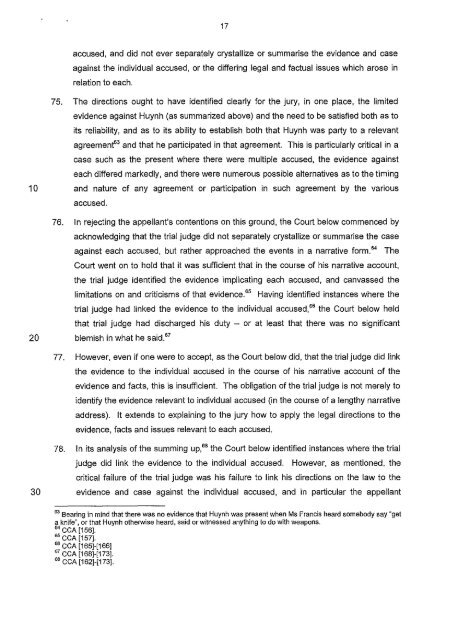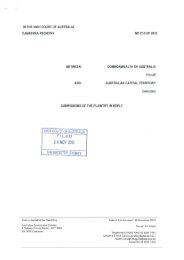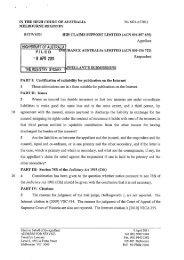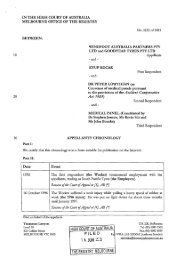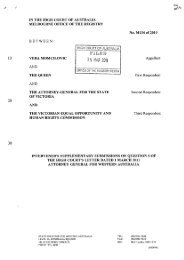Written submissions - High Court of Australia
Written submissions - High Court of Australia
Written submissions - High Court of Australia
You also want an ePaper? Increase the reach of your titles
YUMPU automatically turns print PDFs into web optimized ePapers that Google loves.
17<br />
accused, and did not ever separately crystallize or summarise the evidence and case<br />
against the individual accused, or the differing legal and factual issues which arose in<br />
relation to each.<br />
75. The directions ought to have identified clearly for the jury, in one place, the limited<br />
evidence against Huynh (as summarized above) and the need to be satisfied both as to<br />
its reliability, and as to its ability to establish both that Huynh was party to a relevant<br />
agreement 63 and that he participated in that agreement. This is particularly critical in a<br />
case such as the present where there were multiple accused, the evidence against<br />
each differed markedly, and there were numerous possible alternatives as to the timing<br />
10 and nature <strong>of</strong> any agreement or participation in such agreement by the various<br />
accused.<br />
76. In rejecting the appellant's contentions on this ground, the <strong>Court</strong> below commenced by<br />
acknowledging that the trial judge did not separately crystallize or summarise the case<br />
against each accused, but rather approached the events in a narrative form. 64 The<br />
<strong>Court</strong> went on to hold that it was sufficient that in the course <strong>of</strong> his narrative account,<br />
the trial judge identified the evidence implicating each accused, and canvassed the<br />
limitations on and criticisms <strong>of</strong> that evidence. 5 5 Having identified instances where the<br />
trial judge had linked the evidence to the individual accused, 66 the <strong>Court</strong> below held<br />
that trial judge had discharged his duty - or at least that there was no significant<br />
20 blemish in what he said. 67<br />
77. However, even if one were to accept, as the <strong>Court</strong> below did, that the trial judge did link<br />
the evidence to the individual accused in the course <strong>of</strong> his narrative account <strong>of</strong> the<br />
evidence and facts, this is insufficient. The obligation <strong>of</strong> the trial judge is not merely to<br />
identify the evidence relevant to individual accused (in the course <strong>of</strong> a lengthy narrative<br />
address). It extends to explaining to the jury how to apply the legal directions to the<br />
evidence, facts and issues relevant to each accused.<br />
78. In its analysis <strong>of</strong> the summing up, 68 the <strong>Court</strong> below identified instances where the trial<br />
judge did link the evidence to the individual accused. However, as mentioned, the<br />
critical failure <strong>of</strong> the trial judge was his failure to link his directions on the law to the<br />
30 evidence and case against the individual accused, and in particular the appellant<br />
63<br />
Bearing in mind that there was no evidence that Huynh was present when Ms Francis heard somebody say "get<br />
a knife", or that Huynh otherwise heard, said or witnessed anything to do with weapons.<br />
64<br />
CCA [156].<br />
65<br />
CCA [157].<br />
66<br />
CCA [165]-[166]<br />
67<br />
CCA [168]-[173].<br />
68<br />
CCA [162]-[173].


